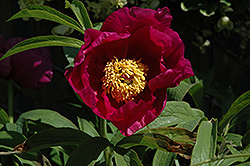It's all about ...
plants

Height: 30 inches
Spacing: 26 inches
Sunlight:
![]()
![]()
Hardiness Zone: 7b
Other Names: Balkan Peony, Coral Peony, syn. Paeonia corallina
Description:
An Old World species with bold single flowers in a rich violet red with prominent butter yellow stamens, great as an accent in the garden or massed in borders; flowers longer when not in full sun; low maintenance
Ornamental Features
Wild Peony features bold lightly-scented violet cup-shaped flowers with red overtones and buttery yellow centers at the ends of the stems in mid spring. The flowers are excellent for cutting. Its compound leaves remain green in colour throughout the season.
Landscape Attributes
Wild Peony is an herbaceous perennial with a more or less rounded form. Its medium texture blends into the garden, but can always be balanced by a couple of finer or coarser plants for an effective composition.
This is a relatively low maintenance plant, and should be cut back in late fall in preparation for winter. It is a good choice for attracting butterflies to your yard, but is not particularly attractive to deer who tend to leave it alone in favor of tastier treats. It has no significant negative characteristics.
Wild Peony is recommended for the following landscape applications;
- Accent
- Mass Planting
- General Garden Use
Planting & Growing
Wild Peony will grow to be about 30 inches tall at maturity, with a spread of 30 inches. When grown in masses or used as a bedding plant, individual plants should be spaced approximately 26 inches apart. It grows at a slow rate, and under ideal conditions can be expected to live for approximately 20 years. As an herbaceous perennial, this plant will usually die back to the crown each winter, and will regrow from the base each spring. Be careful not to disturb the crown in late winter when it may not be readily seen!
This plant does best in full sun to partial shade. It prefers to grow in average to moist conditions, and shouldn't be allowed to dry out. It is not particular as to soil pH, but grows best in rich soils. It is somewhat tolerant of urban pollution. Consider applying a thick mulch around the root zone in winter to protect it in exposed locations or colder microclimates. This species is not originally from North America.
This plant is not reliably hardy in our region, and certain restrictions may apply; contact the store for more information.
